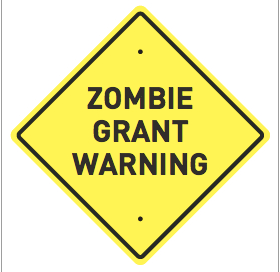There are two ways of writing a grant application, the quick way and the easy way.
The Quick Way
The quick way is to start by writing a set of key sentences. Each key sentence states one of the points that you will need to make in the case for support. These points include the main research goal, what makes the goal important, the sub-goals, the lines of research that will deliver the sub-goals, and so on.
Writing the key sentences is hard work, but it only takes a couple of hours. If you can’t draft a set of key sentences in a couple of hours then you know you are not ready to write a grant application. On the other hand, when you write a set of key sentences you get more than the knowledge that you are ready to write. You get a short-cut to the finished case for support. The key sentences enable you to write the full case for support in a couple of weeks.
The key sentences give you a short cut because the full case for support is simply an expanded version of the key sentences. It consists of a series of sections, each of which begins with a key sentence. Each of the sections should also have a heading that uses phrases from the key sentence. The remainder of each section consists of a few paragraphs that expand and justify the point made by the key sentence.
Not only is it easy to write the case for support with the key sentences, it is easy to keep it short. And if it gets too long it is easy to shorten it. Every section starts by saying what is most important. If you write too much in any section you can trim the unimportant stuff from the end.
The Easy Way
Despite these advantages of the key sentence approach, most writers prefer to write a grant the easy way. They just start writing. If you write the easy way you won’t have the key sentences to guide your writing but you will have saved yourself two hours of dull work, so as long as you can work out what to write you will surely finish sooner if you start the easy way.
It’s obviously best to discuss the most important issues first. Describe your research question and what makes it important to your chosen funder. Pretty soon you will have several pages of text. There’s lots of helpful advice on the web about what you should include. A google search on writing a good research grant application give 37.6 million hits. Some of the top hits in the google search are written by the funders themselves. The funders tell you exactly what to do, in detail. This page on ESRC’s website lists 37 points you should include and 5 questions you should answer. Following this advice will make it very easy to write a lot of text very quickly.
Unfortunately, there is no advice about how to write clearly. The most likely outcome is that the document you write will be a misshapen monster, far too long and completely unreadable. Editing a badly structured document of any kind is futile and utterly miserable. The excellent @thesiswhisperer blog likens the process to fighting a jungle war. If you are unlucky, you will have supportive colleagues who will encourage you to persevere in this miserable task. In fact you should quit and start again.
You should quit because because line-by-line edits do not fix the real problem, the poor structure. The more you edit, the worse it gets. You will work for months and when you finish you will know in your heart of hearts that your case for support is a mess.
Foolishly, you will nurture a vain hope that maybe you are being overly critical because you have been working so hard. You will reach out to your supportive colleagues for reassurance. They will know how hard you have worked and will want to support your morale, rather than help you write a good case for support. When you ask them for comments, they will lie, to protect your morale. They will see that the case for support is a mess, but they want to be supportive, so they will tell you to dot a couple of i’s and cross a couple of t’s and you will breathe a sigh of relief and submit your grant application.
The point at which you discover the truth about your grant application is when you get the results of peer review, nine months after submitting. At this point you will probably no longer be pleased that you saved the two hours it would have taken to write the key sentences.
If you are lucky, when you find yourself with a misshapen monster grant application, you will engage a consultant like me who will tell you some really good news. Your misshapen monster of a grant application can be salvaged. There is an easy way to restructure the case for support that only takes a day or so. You start by writing a set of key sentences……..



